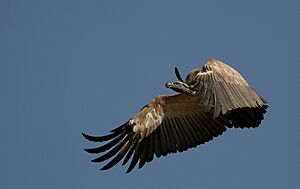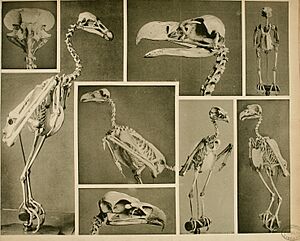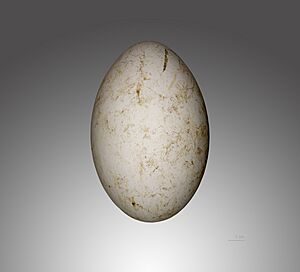Cape vulture facts for kids
Quick facts for kids Cape vulture |
|
|---|---|
 |
|
| A Cape Vulture flying at the Rhino and Lion Nature Reserve in Cradle of Humankind, Gauteng, South Africa | |
| Conservation status | |
| Scientific classification | |
| Genus: |
Gyps
|
| Species: |
coprotheres
|
| Synonyms | |
|
Gyps kolbii |
|
The Cape vulture (Gyps coprotheres) is a large bird of prey found only in southern Africa. It's also known as the Cape griffon or Kolbe's vulture. This amazing bird lives mostly in South Africa, Lesotho, Botswana, and parts of northern Namibia. It builds its nests on high cliffs and lays just one egg each year. In 2015, the Cape vulture was considered an Endangered animal. But by 2021, its numbers had improved, and it was reclassified as a Vulnerable animal. This means it's still at risk, but its future looks a bit brighter!
Contents
What Does a Cape Vulture Look Like?
This big vulture has a creamy-buff color, which is a light yellowish-brown. Its flight feathers and tail feathers are dark, making a nice contrast. Adult vultures are lighter in color than younger ones. Their underwing feathers can look almost white when they are flying high.
The Cape vulture has a head and neck that are mostly bare, meaning they have very few feathers. Its eyes are yellowish, and its beak is black. Young vultures are usually darker and have more streaks on their feathers. Their eyes can be brown to orange, and their necks are red. This vulture looks a lot like the white-backed vulture, but it's bigger and has yellow eyes.
Adult Cape vultures are about 96 to 115 centimeters (about 3 to 3.8 feet) long. Their wings can spread out to 2.26 to 2.6 meters (about 7.4 to 8.5 feet) wide! They weigh between 7 and 11 kilograms (about 15 to 24 pounds). They have two bare skin patches at the base of their neck. Scientists think these patches help them sense temperature and find warm air currents called "thermals" to help them fly.
The Cape vulture is one of the largest raptors in Africa. It's almost as big as the lappet-faced vulture. It's also the third largest Old World vulture on average, after the Himalayan griffon vulture and the cinereous vulture.
Where Do Cape Vultures Live?
Cape vultures live and breed in countries like Botswana, Lesotho, Mozambique, and South Africa. Sometimes, they visit other countries like the Democratic Republic of the Congo and Zambia, but they don't usually stay there. They also fly through Angola, Namibia, Zimbabwe, and Eswatini.
These vultures are "obligate scavengers," which means they only eat carrion (dead animals). They eat soft muscles, organ tissues, and even some bone pieces from carcasses. They are excellent at finding food! They search for dead animals in groups and can spot them from very far away because they have amazing eyesight. This helps them find food much faster than other animals that scavenge on the ground.
How Do Cape Vultures Live?
Raising Their Young
Cape vultures usually build their nests and rest on cliff faces, often in or near mountains. They have been found nesting as high as 3,100 meters (about 10,000 feet) up! In some parts of South Africa, they prefer to nest on ledges that are not too deep and are higher up. They also like to be surrounded by other vultures.
Individual vultures tracked in Namibia had very large "home ranges," which are the areas they travel for food. These areas could be between 11,800 and 22,500 square kilometers (about 4,500 to 8,700 square miles)! They also rest on trees and tall power poles. Both young and adult vultures prefer to rest on cliffs close to their nesting colonies. It's believed that they tend to return to the area where they were born to breed.
After young vultures leave the nest, they still depend on their parents for about 101 days. After this time, they start to fly further away from the nest as they become more independent. Even though they continue to breed, the number of vultures in some areas has gone down. For example, a breeding site called Roberts’ Farm in Magaliesberg was abandoned in 2013.
Why Are Cape Vultures in Danger?
The number of Cape vultures has been steadily decreasing since at least the 1980s. Between 1992 and 2007, the species declined by 60-70% in South Africa alone. By 2021, there were an estimated 9,600 to 12,800 adult vultures left. This is why they are still considered a Vulnerable species.
Many things threaten the Cape vulture. Here are some of the most important problems:
- Not enough food: There isn't always enough large carrion (dead animals) for them to eat, especially when they are nesting.
- Poisoning: Vultures are often poisoned, either on purpose or by accident.
- Loss of habitat: The places where they find food are shrinking.
- Traditional uses: Some vultures are caught for traditional medicine, which is not sustainable.
One specific type of poisoning comes from a medicine called Diclofenac. This drug is used to treat arthritis in cattle. If vultures eat the meat of cattle that have been treated with Diclofenac, it can cause their kidneys to fail, and they die.
Another big danger is electrocution from power lines. Vultures can hit the cables on electricity pylons and die. This is a common cause of death for vultures that have been tagged by scientists.
In June 2019, a terrible event happened in northern Botswana. The bodies of 537 vultures, including 10 Cape vultures, were found. They likely died after eating the carcasses of three elephants that had been poisoned by poachers. Poachers sometimes poison animals to prevent vultures from circling above, which helps park rangers find illegal hunting activity.
Climate change is also a threat. High temperatures and global warming can harm these birds. More needs to be done to change laws to protect vultures better. If all vulture species were given "Specially Protected" status, it could help their populations grow.
Helping Vultures and People Live Together
It's important to solve problems between humans and wildlife. Farmers need to understand the dangers of using poisons. In Namibia, a study in 2015 found that 1.7% of farmers admitted to using poison. In Kenya, over 20% of farmers used poisons to get rid of predators, and many didn't know about the Kenya Wildlife Act.
To help reduce poisoning, awareness campaigns are needed to teach people about the risks. Also, a mix of strict laws and local solutions, like building safe enclosures for livestock or offering money to farmers for losses, can help reduce these conflicts and protect the vultures.






